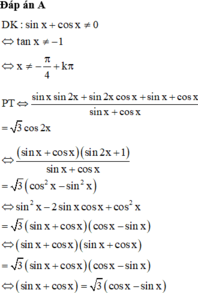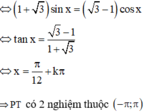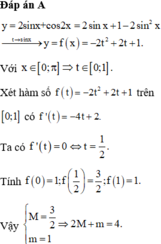Hãy nhập câu hỏi của bạn vào đây, nếu là tài khoản VIP, bạn sẽ được ưu tiên trả lời.

\(\Leftrightarrow1-2sin^2x+\left(2m-3\right)sinx+m-2=0\)
\(\Leftrightarrow2sin^2x-\left(2m-3\right)sinx-m+1=0\)
\(\Leftrightarrow2sin^2x+sinx-2\left(m-1\right)sinx-\left(m-1\right)=0\)
\(\Leftrightarrow sinx\left(2sinx+1\right)-\left(m-1\right)\left(2sinx+1\right)=0\)
\(\Leftrightarrow\left(2sinx+1\right)\left(sinx-m+1\right)=0\)
\(\Leftrightarrow\left[{}\begin{matrix}sinx=-\dfrac{1}{2}\\sinx=m-1\end{matrix}\right.\)
Pt có đúng 2 nghiệm thuộc khoảng đã cho khi và chỉ khi:
\(\left\{{}\begin{matrix}m-1\ne-\dfrac{1}{2}\\-1\le m-1\le1\end{matrix}\right.\) \(\Leftrightarrow\left\{{}\begin{matrix}m\ne\dfrac{1}{2}\\0\le m\le2\end{matrix}\right.\)

a) + Hàm số y = cos x có chu kì 2π.
Do đó: cos 2.(x + kπ) = cos (2x + k2π) = cos 2x.
⇒ Hàm số y = cos 2x cũng tuần hoàn với chu kì π.
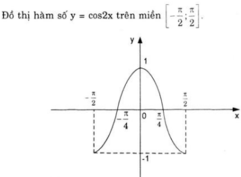
Từ đó suy ra
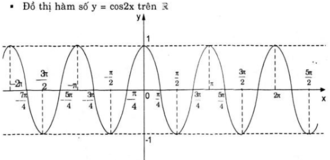
b. y = f(x) = cos 2x
⇒ y’ = f’(x) = (cos 2x)’ = -(2x)’.sin 2x = -2.sin 2x.

⇒ Phương trình tiếp tuyến của đồ thị (C) tại điểm có hoành độ x = π/3 là:

c. Ta có: 1 – cos 2x = 2.sin2x ≥ 0.
Và 1 + cos22x > 0; ∀ x

⇒  luôn xác định với mọi x ∈ R.
luôn xác định với mọi x ∈ R.

a: pi/2<a<pi
=>sin a>0
\(sina=\sqrt{1-\left(-\dfrac{1}{\sqrt{3}}\right)^2}=\dfrac{\sqrt{2}}{\sqrt{3}}\)
\(sin\left(a+\dfrac{pi}{6}\right)=sina\cdot cos\left(\dfrac{pi}{6}\right)+sin\left(\dfrac{pi}{6}\right)\cdot cosa\)
\(=\dfrac{\sqrt{3}}{2}\cdot\dfrac{\sqrt{2}}{\sqrt{3}}+\dfrac{1}{2}\cdot-\dfrac{1}{\sqrt{3}}=\dfrac{\sqrt{6}-2}{2\sqrt{3}}\)
b: \(cos\left(a+\dfrac{pi}{6}\right)=cosa\cdot cos\left(\dfrac{pi}{6}\right)-sina\cdot sin\left(\dfrac{pi}{6}\right)\)
\(=\dfrac{-1}{\sqrt{3}}\cdot\dfrac{\sqrt{3}}{2}-\dfrac{\sqrt{2}}{\sqrt{3}}\cdot\dfrac{1}{2}=\dfrac{-\sqrt{3}-\sqrt{2}}{2\sqrt{3}}\)
c: \(sin\left(a-\dfrac{pi}{3}\right)\)
\(=sina\cdot cos\left(\dfrac{pi}{3}\right)-cosa\cdot sin\left(\dfrac{pi}{3}\right)\)
\(=\dfrac{\sqrt{2}}{\sqrt{3}}\cdot\dfrac{1}{2}+\dfrac{1}{\sqrt{3}}\cdot\dfrac{\sqrt{3}}{2}=\dfrac{\sqrt{2}+\sqrt{3}}{2\sqrt{3}}\)
d: \(cos\left(a-\dfrac{pi}{6}\right)\)
\(=cosa\cdot cos\left(\dfrac{pi}{6}\right)+sina\cdot sin\left(\dfrac{pi}{6}\right)\)
\(=\dfrac{-1}{\sqrt{3}}\cdot\dfrac{\sqrt{3}}{2}+\dfrac{\sqrt{2}}{\sqrt{3}}\cdot\dfrac{1}{2}=\dfrac{-\sqrt{3}+\sqrt{2}}{2\sqrt{3}}\)

Anh/ chị viết rõ đề bằng công thức toán được không ạ?
Vd : 1/2(2x+2y+z)^2 là \(\frac{1}{2\left(2x+2y+z\right)^2}\) hay sao?
\(P=8x^3+8y^3+\frac{z^3}{\left(2x+2y+2z\right)\left(4xy+2yz+2zx\right)}\) đúng ko ạ?

Đáp án B
+ Xét hàm y = f(x) = cos (x + π)
TXĐ: D = R
Với mọi x ∈ D, ta có: -x ∈ D và f(-x) = cos (-x + π) = -cos x = cos (x + π) = f(x)
Do đó y = cos (x + π) là hàm số chẵn .
+ Xét hàm y = g(x) = tan2016x
TXĐ: D = R\{π/2 + kπ, k ∈ Z}
Với mọi x ∈ D, ta có: -x ∈ D và g(-x) = tan2016(-x) = (-tan x)2016 = tan2016x = g(x)
Do đó: y = tan2016x là hàm chẵn trên tập xác định của nó.
+Xét hàm y = cot2x
f(-x) = cot(-2x) = - cot 2x = -f(x) nên đây là hàm số lẻ.
+ Xét hàm số y = 1-sinx
f(-x) = 1- sin(-x) = 1+ sin x
Nên hàm số không chẵn không lẻ

Giả sử \(y\) nằm giữa \(x\) và \(z\)
\(\Rightarrow\left(y-z\right)\left(y-x\right)\le0\)
\(\Leftrightarrow y^2+zx\le xy+zx\)
\(\Leftrightarrow y^2z+z^2x\le xyz+z^2x\)
\(\Leftrightarrow x^2y+y^2z+z^2x\le x^2y+xyz+z^2x=y.\left(x^2+zx+z^2\right)\)
Nên : \(P\le y.\left(x^2+zx+z^2\right)\le y.\left(x+z\right)^2\)
\(=\frac{1}{2}.2y.\left(x+z\right).\left(x+z\right)\le\frac{1}{2}.\left[\frac{2y+x+z+x+z}{3}\right]^3\) \(=\frac{1}{2}\cdot\frac{8}{27}=\frac{4}{27}\)
Dấu "=" xảy ra \(\Leftrightarrow x=0,y=\frac{1}{3},z=\frac{2}{3}\) và các hoán vị.

\(y=\sin^4x+\cos^4x\\ =1-2\sin^2x\cdot\cos^2x\\ =1-\dfrac{1}{2}\sin^22x\\ 0\le\sin^22x\le1\\ \Leftrightarrow\dfrac{1}{2}\le y\le1\\ y_{min}=\dfrac{1}{2}\Leftrightarrow\sin^22x=1\Leftrightarrow x=\dfrac{k\pi}{2}\pm\dfrac{\pi}{4}\\ y_{max}=1\Leftrightarrow\sin^22x=0\Leftrightarrow x=k\pi\)
\(y=3\sin x+4\cos x\\ =5\left(\dfrac{3\sin x}{5}+\dfrac{4\cos x}{5}\right)\\ =5\cos\left(x-a\right),\forall\cos a=\dfrac{4}{5},\sin a=\dfrac{3}{5}\\ -1\le\cos\left(x-a\right)\le1\\ \Leftrightarrow-5\le y\le5\\ y_{min}=-5\Leftrightarrow\cos\left(x-a\right)=-1\\ y_{max}=5\Leftrightarrow\cos\left(x-a\right)=1\)
